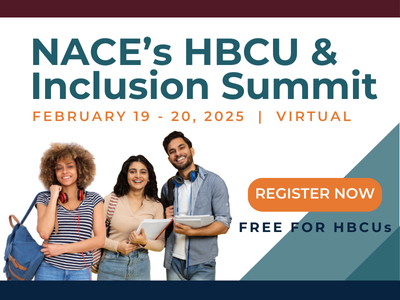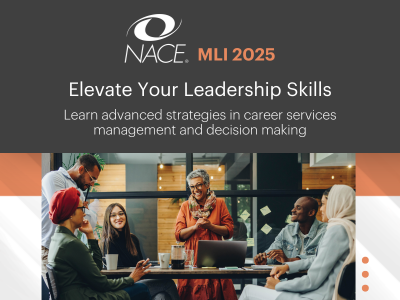Spotlight for Career Services Professionals
Spotlight for Recruiting Professionals
Native students face many challenges during their job search and transition to the workplace. By better understanding and accounting for the obstacles they face, career services and university relations and recruiting professionals can help them achieve their career goals.
“We, as advisers and employers, need to figure out how to carve out space to get to the understanding of how Native students want to serve their community and then get them to actualize solutions to the challenges that they are facing in that trajectory,” according to Jack Soto, senior program manager for career readiness and employment at the American Indian College Fund.
One of the basic challenges in working with Native students in the job search is helping them understand what a job looks like beyond employment versus career, Soto says.
“Native students have an inherent need to impact their communities and there is not clear career conversation around the way that employment feeds that long-term identity structure,” he explains.
“There's not a push for Native students, for example, to become lawyers for the sake of their individual legacy. There's more of an approach where they feel they need to become lawyers because the community needs lawyers. There's a flip in the way that sense making of a career path exists. Because of that, the way that Native students approach the dialogue is different enough that it makes it challenging for them to know specifically how to approach the job search.”
The further challenge in this, Soto says, is that career advising strategies do not always incorporate culture into the dialogue on thinking about work as a career, which makes it hard for Native students to link work to a long-term investment.
“It's leaning into this idea that there’s this structural difference in the way Native students approach the idea of employment; that they can show up and be themselves and that they have skill sets, assets, and characteristics that are helpful to employers,” he adds.
“Further, the student’s needs are important to the conversation—meaning making money to pay bills and live comfortably are important, but it is not the main variable for Native students to find employment. They have an inherent drive to serve community. I am not certain that many career conversations work to include that internal cultural dialogue in a student’s need to find a career path. So, there is learning to be had in both the student and the career advising process.”
He says the hurdle is higher because Native students inherently feel that their passion to do certain work is enough for them to actually do that work. This creates a disconnect to students knowing that certain frameworks of achievement have to be met for them to obtain their desired positions.
“The system says that your passion is super helpful, but you need to jump through all these hoops and attain these types of grades and then apply yourself in a specific way to get your foot in the door to do the work that you want to do,” Soto notes.
“Native students don’t have access to the thinking that the system has built itself up in a way that doesn't allow for passion to be enough to fulfill the destiny of an individual.”
He adds that the Native students and those who advise them do not know how to approach the idea that when an individual is community-driven and trying to solve a problem for the community, a lot of the structure and employment pathways are out of reach.
“This is the inherent problem in helping a Native student carve out a career path,” Soto says.
“This also happens early in the life of a Native student because they do not have social structures that support the idea of investment to one’s education to better support a long-term career objective.”
On the employment side, Native students also face cultural obstacles in the workplace.
“For instance, there's the belief that you have to dress like a white person to be accepted into this environment of professionalism,” Soto says.
“It's another sort of structural issue that we are just beginning to scratch the surface of to create helpful dialogue. Native students feel if they can't show up to work in a ribbon shirt or a ribbon skirt and do their job, and are told that they are too colorful and flashy, then this isn’t the right environment for them.”
This part of the employment structure perpetuates the feeling Native students have that they need to walk in two worlds. This is a disconnect between the reality that stems from a deeper reality that white cultural context is driving the way we see how a person should be, behave, perform, and carry out their duties in a professional environment.
“The bifurcation of identity creates this schizophrenic idea that students have to be Native outside of the professional world and non-Native within it,” Soto explains.
“It drives the thought that they can't be Native outside of the perceived borders of the reservation. Native people who grow up in urban areas feel this as well. It is not completely driven by the notion of just rural life. Overarching cultural norms make any Native feel weird because they are Native and not just segregated by land.”
Soto also points out that Native students often don’t have enough role models who express the idea of employment as a long-term endeavor toward growth as a person to learn how to be helpful to their community.
“This is complex because it exists at both a micro and macro level,” he explains.
“There are not enough Native people who live a ‘normalized’ 9-to-5 work life. That makes it a challenge for Native youth to see that as a behavior they should carry with them. Also, Natives are not pulled into mainstream top-tier management and leadership positions to help Native youth envision a life outside of what they know.”
Indeed, Soto says, Native students should be seeking jobs in which they can demonstrate their capacity and add value to the organization.
“In the work that we do for the College Fund, we try to get them out of the idea that the only job that they're good for when they graduate from college is an entry-level position,” Soto notes.
“The conversation is, again, nuanced. Entry-level jobs are not always where an individual can use skill sets that can support a community’s development. We work to support students to find leadership roles because they can have a stronger and deeper influence in the world/environment they live in over making money.”
Describing what employers want is an awkward conversation for some tribal members to have since some of the people who are leading larger initiatives within the tribes don't have college degrees.
“There are two pieces to this,” Soto says. “In many cases, tribal members want their councils and managers to have an education aligned with their service capacity. In some cases, tribal leaders do not need an education to lead their communities and are supported by their constituents. It is just like any political structure—there is high critique of the public servant.”
In addition, the way that companies work and perform still values competition over passion, which doesn’t align with the typical mindset of the Native student.
“Companies should consider the values they hold and promote those values in their approach,” Soto explains.
“If they want to attract people from communities they want to tap into, show how the organization is solving problems within that environment. If they are solving problems within that community, demonstrate how they are working within that specific community to provide a solution and the values the company holds in connecting with that community. By understanding the people and their lives, companies can build a relationship and rapport and trust. With Native people, there is a connection that is more so about the service aspect of the work than it is about winning the American dream, whatever that might be.”
The reality, however, is that many organizations do not work with the Native population intentionally or drive a message of problem solving for these communities.
“If a company identifies a problem that is impacting their community, pitches that problem, tells the people that they can come work for it to help solve that problem, and they can see what the company is trying to do to help that community, it is going to build a Native workforce,” Soto says.
“Furthermore, once Native students get beyond that entry point to, for instance, middle management, they will go back to the idea of getting more Native people involved in the company.”
Soto recommends that career advisers engage in dialogue about how students want to help their community, and then get beyond that conversation being generalized. Soto describes a conversation he had with a Native student in a group setting. Soto asked him why he was in the culinary program, and he responded that he wants to open his own restaurant.
“It just didn’t seem right—I could tell—and I said I didn’t believe that’s why he was in the program,” Soto recalls.
“It took me several times asking him that question and he finally told the group his story.”
The student, Soto says, grew up in extreme poverty. His mother supported the family by eating out of trash cans. He was homeless for a period of time and lived on the streets.
“He said the real reason he was in culinary school was to learn how to cook with trash and teach others how to find nutritional value in it,” Soto continues.
“He said he also wanted to own his own restaurant, not to make money for himself, but to build a fleet of food trucks to feed more homeless who don't have access to food. I was blown away, but then I understood his motivation. You could hear it … you could feel it.”
Soto asked the student if he was telling people that story. The student said no because he was embarrassed by it.
At that point, Soto looked around the room and some of the students were crying. He asked them if they read that story on a scholarship application, would they give the student money for school? Unanimously, they said they would.
“There is a connection there somewhere and you have to get them to the point of saying that you hear them and that their goals are doable, and then you can help them get where they need to go,” Soto stresses.
“We need to build on this idea of reciprocity. What’s so challenging for our students is that we put them in situations where they feel that they have to be competitive and talk to their skill sets in ways that put them in front of people instead of driving them deeper into their skill sets to uplift their people. That is the work we are awakening in right now.”
Resources for Connecting and Working With Native Students
Jack Soto, senior program manager for career readiness and employment at the American Indian College Fund, compiled and shared the following list of resources to help employers and career services professionals connect and work with Native students:
Scholarship Providers
American Indian College Fund (College Fund) – www.collegefund.org
Indigenous Education, Inc. (IEI) – www.cobellscholar.org
American Indian Science and Engineering Society (AISES) – www.aises.org
American Indian Graduate Center (AIGC) – www.aigcs.org
National Student Organizations with chapters
AISES – college and high school, annual national conference with a structured career fair, college-based student chapters – www.aises.org
American Indigenous Business Leaders (AIBL) – college, annual conference with a business plan competition, college-based student chapters – www.abil.org
United National Indian Tribal Youth, Inc. (UNITY) – high school, annual national conference, community-based student chapters – www.unityinc.org
National Native Education Organizations
American Indian Higher Education Consortium (AIHEC) – www.aihec.org
National Indian Education Association (NIEA) – www.niea.org
National Native Organizations
National Congress of American Indians (NCAI) – www.ncai.org
National Center for American Indian Enterprise Development (NCAIED) – www.ncaied.org
First Nations Development Institute (FNDI) – www.firstnations.org
National Council on Urban Indian Health (NCUIH) – www.ncuih.org
National American Indian Housing Council (NAIHC) www.naihc.net



